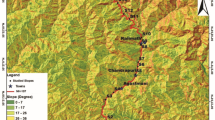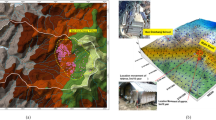Abstract
Due to the rapidly growing population of the city of Ankara (Turkey) and increased traffic congestion, it has become necessary to widen the Ankara-Eskişehir (E-90) highway connecting the newly built areas west of the city to the city center. During widening, several cut slopes were formed along the highway route. As a result, some instability problems (small-sized rock falls/sliding, sloughing, raveling) produced detachment zones along a cut slope in highly jointed, folded and sheared limestone, causing local degradation of the cut slope. Identification of the areas that are likely to detach from the cut slope in the future is considered to be very important for the application of remedial measures. For this purpose, the relationships between the existing detachment zones and various parameters (e.g., point load strength index, weathering, block size, daylighting, shear zone) were investigated using GIS-based statistical detachment susceptibility analyses in order to predict the further aerial extension of the detachment zones with time. During the overlay analyses, statistical index and weighting factor methods were used. The outcomes of the analyses were compared and evaluated with the field observations to check the reliability of the methods and to assess the detachment zones that may develop in the future. The detachment susceptibility map without the block-size layer gives the best result and indicates some risky zones where detachments are likely to occur in the future. Recommendations on remedial measures of the cut slope should consider these risky zones.










Similar content being viewed by others
References
Anon (1970) The logging of rock cores for engineering purposes. Engineering group working party report. Q J Eng Geol 3:1–24
Anon (1995) The description and classification of weathered rocks for engineering purposes. Q J Eng Geol 28:207–242
Bieniawski ZT (1989) Engineering rock mass classification. Mc Graw Hill, New York
Cevik E, Topal T (2003) GIS-based landslide susceptibility mapping for a problematic segment of the natural gas pipeline, Hendek (Turkey). Environ Geol 44:949–962
Cevik E, Topal T (2004) Relocation of a problematic segment of a natural gas pipeline using GIS-based landslide susceptibility mapping, Hendek (Turkey). In: Hack R, Azzam R, Charlier R (eds) Proceedings of the 1st European Regional IAEG conference on engineering geology for infrastructure planning in Europe: a European perspective. Springer, Berlin Heidelberg New York, pp 265–274
Dai FC, Lee CF, Li J, Xu ZW (2001) Assessment of landslide susceptibility on the natural terrain of Lantau Island, Hong Kong. Environ Geol 40:381–391
Dearman WR (1974) Weathering classification in the characterisation of rock for engineering purposes in British practice. Bull Int Assoc Eng Geol 9:33–42
Dearman WR (1991) Engineering geological mapping. Butterworth-Heinemann, Oxford
Donati L, Turrini MC (2002) An objective method to rank the importance of the factors predisposing to landslides with the GIS methodology: application to an area of the Apennines (Valneria; Perugia, Italy). Eng Geol 63:277–289
Fookes PG, Hawkins AB (1988) Limestone weathering: its engineering significance and a proposed classification scheme. Q J Eng Geol 21:7–31
ISRM (1981) In: Brown ET (ed) Rock characterization, testing and monitoring—ISRM suggested methods. Pergamon Press, Oxford
ISRM (1985) Point load test, suggested method for determining point load strength. Int J Rock Mech Mining Sci Geomech Abstr 22:51–60
Lee S, Choi J (2004) Landslide susceptibility mapping using GIS and the weight-of-evidence model. Int J Geograph Inf Sci 18:789–814
Lee S, Choi J, Min K (2002) Landslide susceptibility analysis and verification using the Bayesian probability model. Environ Geol 43:120–131
Microimages (2000) TNT-MIPS, scientific sofware-the map and image processing system. Version 6.2. Microimages Inc., USA
Moye DG (1955) Engineering geology for the Snowy Mountain scheme. J Inst Eng 27:287–298
Pachauri AK, Gupta PV, Chander R (1998) Landslide zoning in a part of the Garhwal Himalayas. Environ Geol 36:325–334
Ruxton BP, Berry L (1957) Weathering of granite and associated erosional features in Hong Kong. Bull Geol Soc Am 68:1263–1292
Sarıaslan MM, Yurdakul ME, Osmançelebioğlu R, Basa F, Erkal T, Keçer M, Şentürk K, Mutlu G, Aktimur HT (1998) Ankara ilinin çevre jeolojisi ve doğal kaynakları. MTA. Derleme No:10069
Suzen ML, Doyuran V (2004) A comparison of the GIS based landslide susceptibility assessment methods: multivariate versus bivariate. Environ Geol 45:665–679
Van Westen CJ (1997) Statistical landslide hazard analysis. ILWIS 2.1 for windows application guide. ITC Publication, Enschede, pp 73–84
Van Westen CJ, Terlien TJ (1996) An approach towards deterministic landslide hazard analysis in GIS. A case study from Manizales (Colombia). Earth Surf Process Landforms 21:853–868
Acknowledgements
The authors gratefully acknowledge Dr. M. L. Süzen for his valuable comments on this study and C. Kolat for her support during the use of the GIS-software. The authors also thank Deborah S. K. Thomas for her comments on the use of language and the anonymous reviewer of this journal for the constructive comments and suggestions on the manuscript.
Author information
Authors and Affiliations
Corresponding author
Rights and permissions
About this article
Cite this article
Oztekin, B., Topal, T. GIS-based detachment susceptibility analyses of a cut slope in limestone, Ankara—Turkey. Environ Geol 49, 124–132 (2005). https://doi.org/10.1007/s00254-005-0071-6
Received:
Accepted:
Published:
Issue Date:
DOI: https://doi.org/10.1007/s00254-005-0071-6




